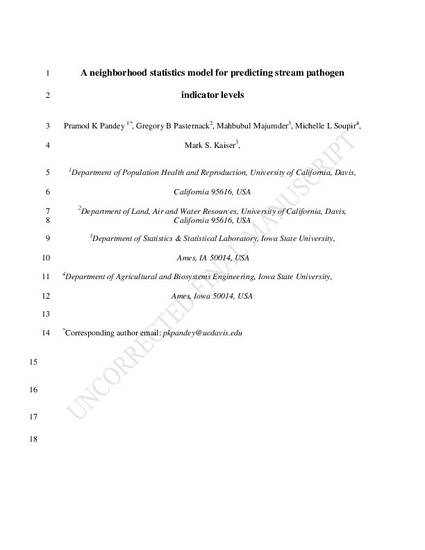
Because elevated levels of water-borne Escherichia coli in streams are a leading cause of water quality impairments in the U.S., water-quality managers need tools for predicting aqueous E. coli levels. Presently, E. coli levels may be predicted using complex mechanistic models that have a high degree of unchecked uncertainty or simpler statistical models. To assess spatio-temporal patterns of instream E. coli levels, herein we measured E. coli, a pathogen indicator, at 16 sites (at four different times) within the Squaw Creek watershed, Iowa, and subsequently, the Markov Random Field model was exploited to develop a neighborhood statistics model for predicting instream E. coli levels. Two observed covariates, local water temperature (degrees Celsius) and mean cross-sectional depth (meters), were used as inputs to the model. Predictions of E. coli levels in the water column were compared with independent observational data collected from 16 in-stream locations. The results revealed that spatio-temporal averages of predicted and observed E. coli levels were extremely close. Approximately 66 % of individual predicted E. coli concentrations were within a factor of 2 of the observed values. In only one event, the difference between prediction and observation was beyond one order of magnitude. The mean of all predicted values at 16 locations was approximately 1 % higher than the mean of the observed values. The approach presented here will be useful while assessing instream contaminations such as pathogen/pathogen indicator levels at the watershed scale.
Available at: http://works.bepress.com/michelle_soupir/64/

This is a manuscript of an article published as Pandey, Pramod K., Gregory B. Pasternack, Mahbubul Majumder, Michelle L. Soupir, and Mark S. Kaiser. "A neighborhood statistics model for predicting stream pathogen indicator levels." Environmental Monitoring and Assessment 187, no. 3 (2015): 124. The final publication is available at Springer via https://doi.org/10.1007/s10661-014-4228-1. Posted with permission.